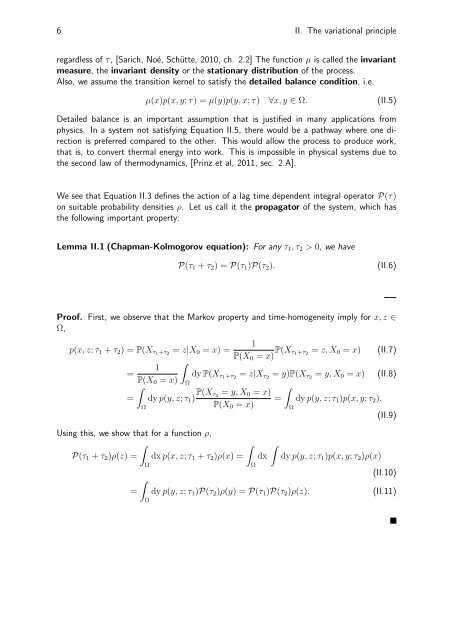Variational Principles in Conformation Dynamics - FU Berlin, FB MI
Variational Principles in Conformation Dynamics - FU Berlin, FB MI
Variational Principles in Conformation Dynamics - FU Berlin, FB MI
- No tags were found...
You also want an ePaper? Increase the reach of your titles
YUMPU automatically turns print PDFs into web optimized ePapers that Google loves.
6 II. The variational pr<strong>in</strong>cipleregardless of τ, [Sarich, Noé, Schütte, 2010, ch.2.2]Thefunctionµ is called the <strong>in</strong>variantmeasure, the<strong>in</strong>variant density or the stationary distribution of the process.Also, we assume the transition kernel to satisfy the detailed balance condition, i.e.µ(x)p(x, y; τ) =µ(y)p(y, x; τ) ∀x, y ∈ Ω. (II.5)Detailed balance is an important assumption that is justified <strong>in</strong> many applications fromphysics. In a system not satisfy<strong>in</strong>g Equation II.5, therewouldbeapathwaywhereonedirectionis preferred compared to the other. This would allow the process to produce work,that is, to convert thermal energy <strong>in</strong>to work. This is impossible <strong>in</strong> physical systems due tothe second law of thermodynamics, [Pr<strong>in</strong>z et al, 2011, sec. 2.A].We see that Equation II.3 def<strong>in</strong>es the action of a lag time dependent <strong>in</strong>tegral operator P(τ)on suitable probability densities ρ. Let us call it the propagator of the system, which hasthe follow<strong>in</strong>g important property:Lemma II.1 (Chapman-Kolmogorov equation): For any τ 1 ,τ 2 > 0, wehaveP(τ 1 + τ 2 )=P(τ 1 )P(τ 2 ).(II.6)Proof. First, we observe that the Markov property and time-homogeneity imply for x, z ∈Ω,1p(x, z; τ 1 + τ 2 )=P(X τ1 +τ 2= z|X 0 = x) =P(X 0 = x) P(X τ 1 +τ 2= z,X 0 = x) (II.7)1=dy P(X τ1 +τP(X 0 = x)2= z|X τ2 = y)P(X τ2 = y, X 0 = x) (II.8)Ω= dy p(y, z; τ 1 ) P(X τ 2= y, X 0 = x)= dy p(y, z; τ 1 )p(x, y; τ 2 ).ΩP(X 0 = x)Ω(II.9)Us<strong>in</strong>g this, we show that for a function ρ,P(τ 1 + τ 2 )ρ(z) = dx p(x, z; τ 1 + τ 2 )ρ(x) ==ΩΩΩdxdy p(y, z; τ 1 )P(τ 2 )ρ(y) =P(τ 1 )P(τ 2 )ρ(z).dy p(y, z; τ 1 )p(x, y; τ 2 )ρ(x)(II.10)(II.11)









